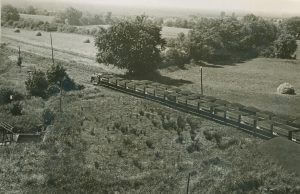16 Cubic Metre Wagon
Type – I, II, and III
 This wagon is used to transport milled peat from the bog stock piles to power stations and briquette factories.
This wagon is used to transport milled peat from the bog stock piles to power stations and briquette factories.
The underframe and body are constructed in standard steel sections. The body sides, ends and flooring are sheeted with aluminium plate. Swaged ribs are pressed in the side and end sheeting for stiffness. A sprung buffer with coupling pin is fitted in each end of the underframe.
The underframe is supported on two diamond type four-wheeled bogies via a spherical swivel bracket and socket exactly as for the 16 cu. metre sod peat wagon.
Since these wagons are discharged by rotary tippler the bogies are permanently secured to the underframe while maintaining the flexibility of movement relative to the underframe.
The bogies are exactly the same as for the 16 cu. metre sod peat wagon.
The variations between Type I and II are minor only and are in respect of detail construction.
The variations between Type I and II on one hand and Type III on the other, are in detail construction, additional fitments to facilitate automatic equipment associated with tippler plant and the bogie centres are increased.
16 Cubic Metre Wagon
Type – Standard

This wagon is used to transport sod peat from the bog ricks, to power stations and tip heads.
The wagon has an underframe and body frame made up from standard steel sections. The underframe is floored with heavy gauge corrugated aluminium sheeting, while the sides and one end are screened with flat steel bars suitably spaced to retain the sod peat. The other end of the body is fitted with a door of angle section framework and sheeted with steel plate. The door is hinged at the top and quick release latching gear is fitted at the bottom. A sprung buffer with coupling pin is fitted in each end of the underframe and lifting brackets are fitted on the side members. A pivot bracket with spherical seating and central pin is fitted at two points on the under frame, to register into a central socket on each of the two bogies. Locking gear is provided on the bogies, which is manually released to allow the load of peat to be hoisted by crane, leaving the two bogies on the rail track to await the return of the empty wagon body.
Each of the diamond bogies has four wheels running on taper roller bearings on dead axles. The axles are connected to each other by flat bar frames at each end and these support the load-carrying beam, via springs. The pivot socket, located in the centre of the sprung beam, allows limited movement of the wagon on the bogie in all directions and to achieve vertical stability, side rollers are fitted on the underframe over one bogie, to bear on flat plates provided on the bogie beam. The underframe is, therefore, virtually three point mounted.